Blog
How Did I Not Know About This?
I should have known better than to trust my phone's GPS. It has been intent on sending me on fool's errands from the beginning. A route that should have taken 30 minutes took much longer since the sweet-voiced phone lady giving me vocal instructions directed me to turn on a "shortcut" route and we ended up on a narrow, pot-holed, dirt trail that bore no resemblance to a road. The cramped pathway passed by old sheds and fishing camps with wash hanging out on clothes lines and chickens running around unmindful of vehicular traffic. I only hoped that the residents didn't object to my driving in their back yards. Then I looked up and slammed on the brakes. We had come to a Railroad.Track. Now, this was no ordinary railroad track. This was an elevated railway built on a mound of dirt about 10 feet high that towered over my car. The drive up and over the rails was so steep that I couldn't even walk it to make sure there actually was a road on the other side and this wasn't just an earthen dam holding waters from the lake. LaVerne and I sat there looking up at the track and wondering what to do. I finally asked if she was game to try it and she replied "I'm down. Let's do it," or words to that effect. So in one of our best Thelma and Louise moments, I dropped the gear shift to low, gunned the engine and we shot straight up in the air. When I looked out the windshield, all I could see was blue sky and the tops of trees! We soon relaxed as we passed over the tracks to start our descent and saw the welcome, meandering road on the other side. We had reached our destination!
We left Houston a day before our railroad adventure and headed north on I69/US 59 traveling to Marshall, Texas. I had heard of the Marshall, Jefferson, Caddo Lake area but for some reason that part of Texas had not been on my radar when it came to taking trips around the state. Now the time had arrived for LaVerne and me to strike out on our great East Texas Adventure.
Marshall is located in an area of the state that was established primarily for cotton plantations. The actual town was founded in 1841 and soon became a major population area in Texas. Several stage coach lines had routes through the town and with the arrival of the railroad, Marshall became known as the Gateway to Texas. 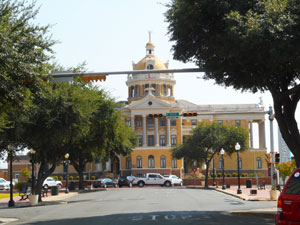 By1860, the town was the fourth-largest city in the state. Marshall played a prominent role during the Civil War and the reconstruction era. Unfortunately, many of Marshall's historic landmarks were torn down for redevelopment but in the late 1900s, historic preservation became important and other properties were saved from the wrecking ball. The city now is pursuing tourism for the economy and has added two major events to promote Marshall as a tourist destination - The Fire Ant Festival and the Wonderland of Lights. The light event runs from the end of November until after Christmas and has become one of the largest and most popular festivals in the United States. After touring the downtown area and taking photos of the picturesque Old Harrison County Courthouse, we drove north again on US59 to Jefferson, Texas.
By1860, the town was the fourth-largest city in the state. Marshall played a prominent role during the Civil War and the reconstruction era. Unfortunately, many of Marshall's historic landmarks were torn down for redevelopment but in the late 1900s, historic preservation became important and other properties were saved from the wrecking ball. The city now is pursuing tourism for the economy and has added two major events to promote Marshall as a tourist destination - The Fire Ant Festival and the Wonderland of Lights. The light event runs from the end of November until after Christmas and has become one of the largest and most popular festivals in the United States. After touring the downtown area and taking photos of the picturesque Old Harrison County Courthouse, we drove north again on US59 to Jefferson, Texas.
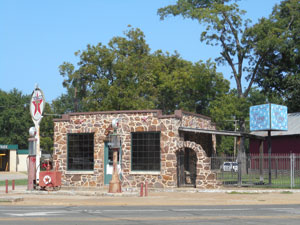 Jefferson has a population of around 1,900 residents and the city is spread out over a four square mile area. One of the first buildings we saw was an early day stone gas station. The old pumps in front of the station still had the glass jars on top that were used to hold gasoline. Seeing the old structure was the first inkling we had of the rich and diverse history of the town. While driving around, we came across the tourism office. We decided to stop and pick up some pamphlets with information about places of interest. That was the best decision we made. Inside we met Kevin Godfrey, the Director of Tourism for the city, and he took the time to tell us everything we wanted to know about Jefferson. His enthusiasm and pride in the area was so obvious that it was contagious and the more he talked, the more I kept asking questions. Kevin patiently took the time to make sure all questions were answered. He also gave me permission to use whatever information from his city website that I wanted so, with a little plagarism, here is the history of Jefferson.
Jefferson has a population of around 1,900 residents and the city is spread out over a four square mile area. One of the first buildings we saw was an early day stone gas station. The old pumps in front of the station still had the glass jars on top that were used to hold gasoline. Seeing the old structure was the first inkling we had of the rich and diverse history of the town. While driving around, we came across the tourism office. We decided to stop and pick up some pamphlets with information about places of interest. That was the best decision we made. Inside we met Kevin Godfrey, the Director of Tourism for the city, and he took the time to tell us everything we wanted to know about Jefferson. His enthusiasm and pride in the area was so obvious that it was contagious and the more he talked, the more I kept asking questions. Kevin patiently took the time to make sure all questions were answered. He also gave me permission to use whatever information from his city website that I wanted so, with a little plagarism, here is the history of Jefferson.
The settlement was founded in the early 1840's and is the fifth oldest town in Texas. Jefferson's early growth was attributed to its location on the Big Cypress Bayou. The bayou allowed for steamboats, paddlewheel boats, and other river traffic to bring vessels further inland and the bend in the bayou provided enough room for the steamboats to turn around for the return trip down the bayou. By 1845, boats were regularly landing in Jefferson bringing passengers and cotton making Jefferson a leading commercial and distribution center. It was one of the state's major ports second only to Galveston in total tonnage. The river was used to carry Union and Confederate soldiers (not at the same time!) to Jefferson for relocation to other areas of the state. Jefferson's population grew to more than 30,000 inhabitants and was the sixth largest town in Texas. 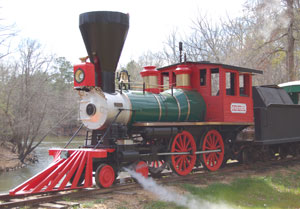 Unfortunately, in 1873, the US Corps of Engineers removed a several hundred years old natural log jam in the area that had clogged the river and raised the level of the water allowing steamboats to make the journey to Jefferson. The destruction of the log jam, along with the Texas and Pacific Railroad bypassing Jefferson, on the run from Texarkana to Marshall caused a sudden downturn in business with many residents moving to other areas. By 1885, the population had dwindled to around 3,500 people. In spite of the problems, Jefferson had a lot of important firsts for the state. In 1867 the town became the first to use gas lighting and a year later, ice was made artificially in large enough quantities for commercial use. Historic points of interest include an old steam engine locomotive and the train trestle. The steam locomotive is one of only ten of its type in the United States and of that ten, it is one of two that still run. The Howe Truss train trestle was built in 1898 and is the last one of that design in the country. The trestle is lighted every evening from dusk to dawn in a spectacular LED light show.
Unfortunately, in 1873, the US Corps of Engineers removed a several hundred years old natural log jam in the area that had clogged the river and raised the level of the water allowing steamboats to make the journey to Jefferson. The destruction of the log jam, along with the Texas and Pacific Railroad bypassing Jefferson, on the run from Texarkana to Marshall caused a sudden downturn in business with many residents moving to other areas. By 1885, the population had dwindled to around 3,500 people. In spite of the problems, Jefferson had a lot of important firsts for the state. In 1867 the town became the first to use gas lighting and a year later, ice was made artificially in large enough quantities for commercial use. Historic points of interest include an old steam engine locomotive and the train trestle. The steam locomotive is one of only ten of its type in the United States and of that ten, it is one of two that still run. The Howe Truss train trestle was built in 1898 and is the last one of that design in the country. The trestle is lighted every evening from dusk to dawn in a spectacular LED light show.
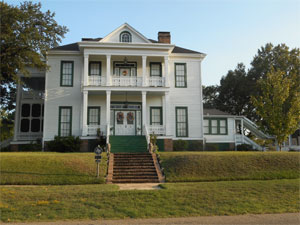 Today, Jefferson is home to more state registered historic structures than any other town in Texas. The town boasts many beautifully restored mid-nineteenth century homes that are featured in an annual Pilgrimage. At this event visitors can view the authentically furnished homes that give tribute to Jefferson's historic past. Jefferson is also known as the Bed and Breakfast capital of Texas and has a reputation for being one of the "most haunted" towns in the state. In 2017, a proclamation was signed making Jefferson the Bigfoot Capital of Texas. The town values its history and has done a wonderful job of preserving the original buildings. One such building is the Excelsior House Hotel. The hotel has been receiving travelers since the late 1850's. The lobby is furnished with beautiful Victorian antiques of the period and in the lobby, LaVerne and I found a long, glass cased display table that held hotel registries from as far back as the opening of the hotel. We saw the signatures of Ulysses S. Grant, Rutherford B. Hayes, and Lady Bird Johnson as well as many others who were
Today, Jefferson is home to more state registered historic structures than any other town in Texas. The town boasts many beautifully restored mid-nineteenth century homes that are featured in an annual Pilgrimage. At this event visitors can view the authentically furnished homes that give tribute to Jefferson's historic past. Jefferson is also known as the Bed and Breakfast capital of Texas and has a reputation for being one of the "most haunted" towns in the state. In 2017, a proclamation was signed making Jefferson the Bigfoot Capital of Texas. The town values its history and has done a wonderful job of preserving the original buildings. One such building is the Excelsior House Hotel. The hotel has been receiving travelers since the late 1850's. The lobby is furnished with beautiful Victorian antiques of the period and in the lobby, LaVerne and I found a long, glass cased display table that held hotel registries from as far back as the opening of the hotel. We saw the signatures of Ulysses S. Grant, Rutherford B. Hayes, and Lady Bird Johnson as well as many others who were 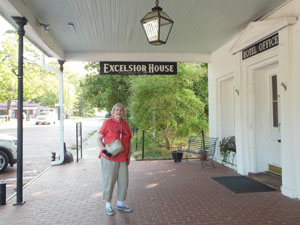 guests of the hotel over the years. Across the street from the hotel, the railcar of Jay Gould, founder of the Texas & Pacific Railway,
guests of the hotel over the years. Across the street from the hotel, the railcar of Jay Gould, founder of the Texas & Pacific Railway, 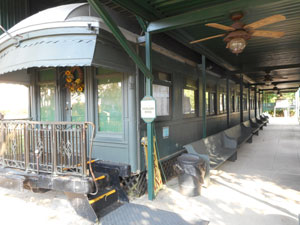 is on display. The parlor car has a luxuriously outfitted interior with four staterooms plus a lounge, dining room, kitchen, and even a ballroom! He evidently liked to travel in comfort. We toured an area where many of the original old mansions are still lived in today. Jefferson was remarkably far-sighted in not tearing down the early buildings and homes as they now add a genuine romantic feeling to the city. Just walking on a street where antique shops are nestled in historic old buildings and surrounded by Victorian homes operating as bed and breakfast hotels, gives a palpable heartbeat to the history of the city and visitors are transported back in time to earlier, simpler days.
is on display. The parlor car has a luxuriously outfitted interior with four staterooms plus a lounge, dining room, kitchen, and even a ballroom! He evidently liked to travel in comfort. We toured an area where many of the original old mansions are still lived in today. Jefferson was remarkably far-sighted in not tearing down the early buildings and homes as they now add a genuine romantic feeling to the city. Just walking on a street where antique shops are nestled in historic old buildings and surrounded by Victorian homes operating as bed and breakfast hotels, gives a palpable heartbeat to the history of the city and visitors are transported back in time to earlier, simpler days.
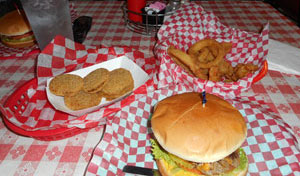 After our afternoon of discovering and touring, we felt the pangs of hunger and chose The Hamburger Store as a place to eat. Jefferson has many restaurants ranging from fine dining at the Stillwater Inn to Pizza at Bulldog Pizza. We had a wonderful cheeseburger with sides of yummy onion rings and fried green tomatoes. I was a happy tripper with my brain full and my body well-sated from a good dinner. As we walked to the car, I looked around the area and vowed that I soon would return to Jefferson. That's the sign of a good visit!
After our afternoon of discovering and touring, we felt the pangs of hunger and chose The Hamburger Store as a place to eat. Jefferson has many restaurants ranging from fine dining at the Stillwater Inn to Pizza at Bulldog Pizza. We had a wonderful cheeseburger with sides of yummy onion rings and fried green tomatoes. I was a happy tripper with my brain full and my body well-sated from a good dinner. As we walked to the car, I looked around the area and vowed that I soon would return to Jefferson. That's the sign of a good visit!
The next morning after our encounter with the railroad tracks, 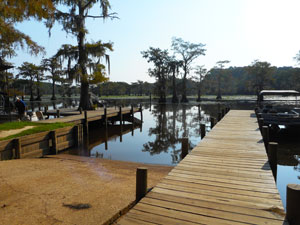 we arrived at Caddo Lake. Our tour guide was standing at the marina waiting to greet us. As we parked and were walking to meet him, I had a chance to get my first glimpse of the lake. It was strikingly beautiful. The still, dark waters were silently broken by magnificent Bald Cypress trees atop wide, commanding trunks that rose straight from the water. The graceful limbs of the trees were loaded but, not suffocated with long drapings of Spanish moss and the clear blue sky framed the top of the scenery to make the perfect backdrop for the landscape.
we arrived at Caddo Lake. Our tour guide was standing at the marina waiting to greet us. As we parked and were walking to meet him, I had a chance to get my first glimpse of the lake. It was strikingly beautiful. The still, dark waters were silently broken by magnificent Bald Cypress trees atop wide, commanding trunks that rose straight from the water. The graceful limbs of the trees were loaded but, not suffocated with long drapings of Spanish moss and the clear blue sky framed the top of the scenery to make the perfect backdrop for the landscape. 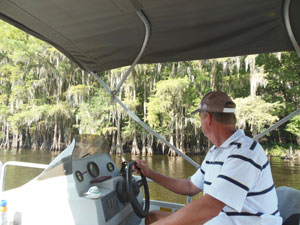 The lake was unusually clean without a lot of invasive plants choking the water. Sizable floating gardens of Lily Pads hung close to the trees and along the shores. The white flowers of the aquatic plant were a perfect contrast to the green trees and dark waters. There was a sense of quiet on the bayou and we were excited to climb aboard the Pontoon boat and start our tour adventure. Rich McFarland with Caddo Lake Bayou Tours was our guide. He's from the area and has an excellent knowledge of the lake and the surrounding environs. He explained that the Caddo Indian tribe inhabited the region in the early 1800's and were gradually displaced by the immigration of European Americans settling in the area.
The lake was unusually clean without a lot of invasive plants choking the water. Sizable floating gardens of Lily Pads hung close to the trees and along the shores. The white flowers of the aquatic plant were a perfect contrast to the green trees and dark waters. There was a sense of quiet on the bayou and we were excited to climb aboard the Pontoon boat and start our tour adventure. Rich McFarland with Caddo Lake Bayou Tours was our guide. He's from the area and has an excellent knowledge of the lake and the surrounding environs. He explained that the Caddo Indian tribe inhabited the region in the early 1800's and were gradually displaced by the immigration of European Americans settling in the area. 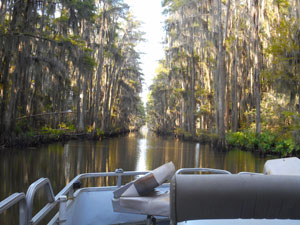 The lake was used by Steamboats that navigated from New Orleans to Jefferson until the log jam cleared and the passageway was no longer deep enough for large vessels. The lake is a maze of waterways cut through for shorter connections across the water. The cuts provide a distinct straight-line path surrounded on both sides with large Bald Cypress trees whose canopies are intertwined at the top providing a leafy roof over the inlet with Spanish moss hanging down from branches as welcoming decorations to visiting boat travelers. Curved roots called "knees" rise from the water around the base of the trees and looked like primitive carvings from a long ago day.
The lake was used by Steamboats that navigated from New Orleans to Jefferson until the log jam cleared and the passageway was no longer deep enough for large vessels. The lake is a maze of waterways cut through for shorter connections across the water. The cuts provide a distinct straight-line path surrounded on both sides with large Bald Cypress trees whose canopies are intertwined at the top providing a leafy roof over the inlet with Spanish moss hanging down from branches as welcoming decorations to visiting boat travelers. Curved roots called "knees" rise from the water around the base of the trees and looked like primitive carvings from a long ago day.
While traveling through the maze of waterways, we had a chance to notice many of the birds in the area. 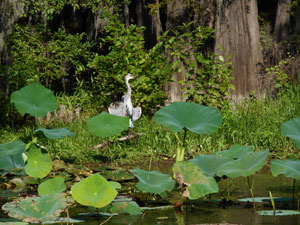 We saw a lot of Blue Herons idly perching on navigation posts or hanging out on the Lily Pads, passing the time of day. Rich told us that there are over 200 varieties of birds, 90 different species of fish and reptiles, and 47 different types of mammals. I had to ask if Bigfoot fell into the mammal count since it is widely "reported" that Sasquatch has been spotted around the lake numerous times. Oddly enough, Caddo Lake also became famous for having pearls in the lake waters. As the story goes, a cook from Japan found pearls in the freshwater mussels taken from the lake. Supposedly, he sold one to Tiffany's Jewelry store for $1,500.00 and that brought an influx of divers seeking their fortune by plunging to the depths of the mysterious waters in the lake. That didn't last too long since shortly afterward, a dam was built that covered the mussel beds in the lake and the great pearl rush was sadly finished.
We saw a lot of Blue Herons idly perching on navigation posts or hanging out on the Lily Pads, passing the time of day. Rich told us that there are over 200 varieties of birds, 90 different species of fish and reptiles, and 47 different types of mammals. I had to ask if Bigfoot fell into the mammal count since it is widely "reported" that Sasquatch has been spotted around the lake numerous times. Oddly enough, Caddo Lake also became famous for having pearls in the lake waters. As the story goes, a cook from Japan found pearls in the freshwater mussels taken from the lake. Supposedly, he sold one to Tiffany's Jewelry store for $1,500.00 and that brought an influx of divers seeking their fortune by plunging to the depths of the mysterious waters in the lake. That didn't last too long since shortly afterward, a dam was built that covered the mussel beds in the lake and the great pearl rush was sadly finished.
Caddo Lake is a Texas State Park and has the amenities that state parks offer: campsites, screened shelters, or historic cabins that can be rented. There are several miles of trails and rangers lead programs on the nature and history of the park and surrounding area. You can also download an Interpretive Guide to Caddo Lake State Park on the park's website. I totally recommend a boat tour of the lake since it provides a stunning overview of the water and the beautiful Bald Cypress trees. Rich was a wonderful guide and provided a great running commentary on points of interest along the tour.
All in all, this was a fantastic Graytripper introduction to East Texas. We saw some awesome sights, met some awesome people, ate some awesome food, and learned more about my favorite subject - Texas History. If anyone has not visited the area, I encourage you to make time in your schedule to visit this part of the state. I will definitely go back and would love to meet you on the road. In fact, if enough people want to visit, we could possibly arrange a Graytripper Tour! Just let me know.
Let us know what your favorite things to do or places to go were when you were younger. Go to the CONTACT US page and email the information or any comment you have about the trips that have been featured. We always want to hear from our friends and neighbors!